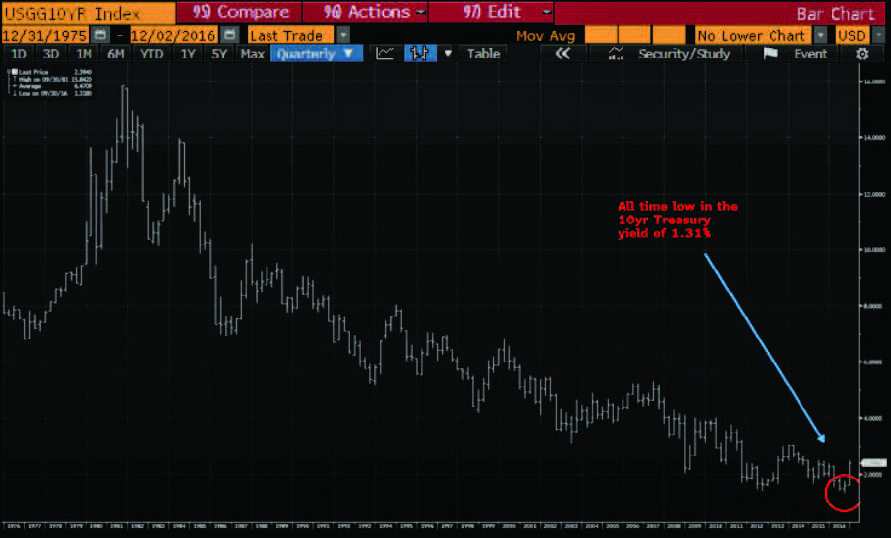[media-downloader media_id=”2128″ texts=”Download PDF” class=”cherry-btn”]
Index Month / Year to Date
Dow Jones +5.86% / +12.37%
S&P 500 +3.69% / +9.64%
NASDAQ +3.78% / +8.05%
10-yr Treasury 1.82% end of October & 2.38% end of November
Markets:
It looks like the British aren’t the only citizens who disagree with the “New World Order (NWO)” agenda, as Americans have elected a non traditional president. This has sparked a “risk-on” trade, meaning that U.S. Treasuries are being sold, and the equity markets (as you can see from the monthly returns above) are being purchased with strong conviction.
So, how will the new administration affect your investment portfolio? As the graph of the 10-year U.S. Treasury yield shows below, it appears that the historic low for U.S. interest rates could now be over. It’s been a great run. Since 1981 — when the 10-year Treasury yield reached 15.84% — we’ve had a nice, overall downhill movement in yields — meaning there has been an overall increase in bond prices for 35 years! With that trend possibly ending, I want to stress the importance of active fixed-income management. In the past, one could make a case for passive fixed-income management. For instance, if you had a long holding period, you could just purchase bonds and wait 10 years, and you’d probably make money in addition to your coupon payments. Now, investors might need to actively manage their fixed-income investments, since we could be turning a corner with domestic rates.

Source: Bloomberg (Chart shows the 10-yr Treasury yield from 1975 to 2016)
If the 1.31% yield that the 10-year Treasury reached on September 30 of this year does turn out to represent the all-time low for decades to come, then actively managing a fixed-income portfolio, with regard to credit risk, duration, and convexity risk, becomes even more important. This is because we could be swimming upstream from this point on. One may still make money investing in bonds, but more skill and strategizing will likely be needed going forward.
Though the new administration’s detailed plans are still forthcoming, potential winners include financials, pharmaceuticals, steel manufacturers, oil/gas refining, transportation, and infrastructure companies. Some industries that could be at risk include Medicaid managed-care companies, technology, hospital operators, telecoms, and utilities. Extremely interest-rate-sensitive companies that are highly leveraged could see mixed results. Since their cost of business might be going up, a cut in corporate tax rates could help any profit margin pressure from increased interest rates. It is still too early to know who all the winners and losers will be with the new administration, of course, but there has definitely been a rotation of sectors this month.
<hr />
<div class=”disclaimer”><strong>Disclaimer:</strong>
You are advised to give independent consideration to, and conduct independent investigation with regards to, the information above in accordance with your individual investment objectives. Use of the Information is at the reader’s risk, is strictly intended for informational purposes in conjunction with the recipient’s due diligence, and should not be construed as a solicitation by Sound Income Strategies, LLC. Past performance will never indicate or guarantee future behavior. Sound Income Strategies, LLC does not represent or warrant that the contents of the document are suitable for you from compliance, regulatory, legal, or any other perspective. We shall have no responsibility or liability for your use or non-use of the document or any portion thereof. Sound Income Strategies, LLC is registered as an investment advisor under the Investment Advisors Act of 1940 and is regulated by the SEC. Sound Income Strategies, LLC and its affiliates may only transact business or render personalized investment advice in those states and jurisdictions where we are registered or otherwise qualified to do so.</div>
